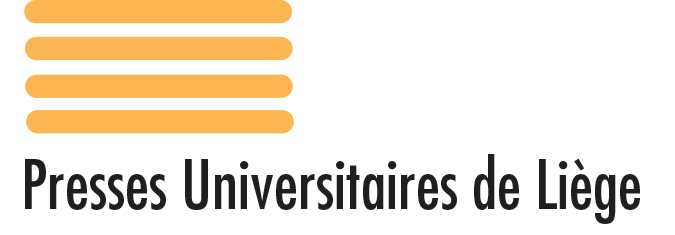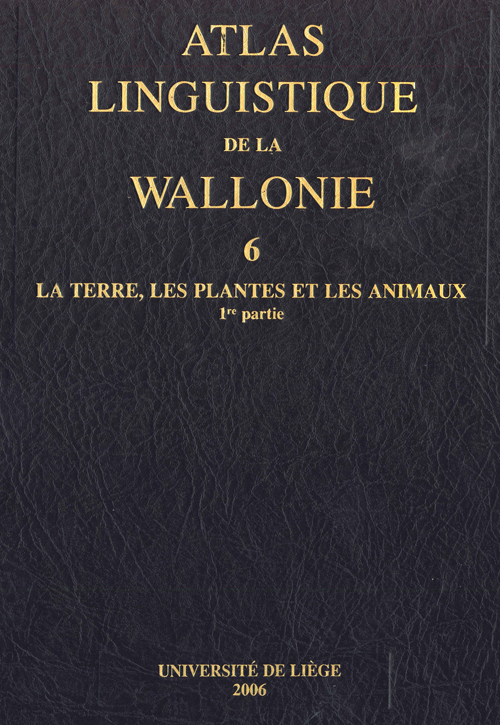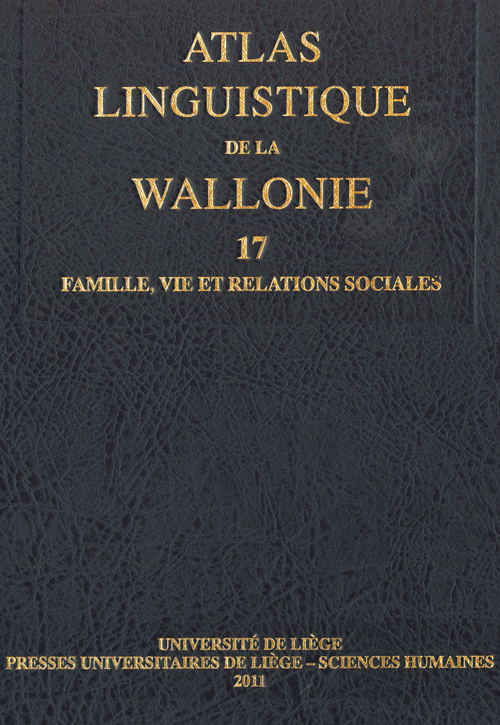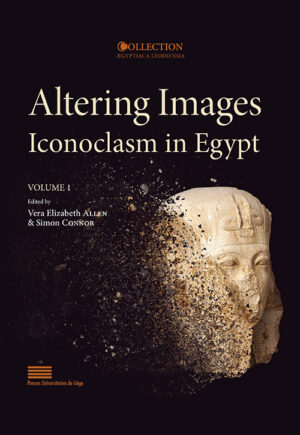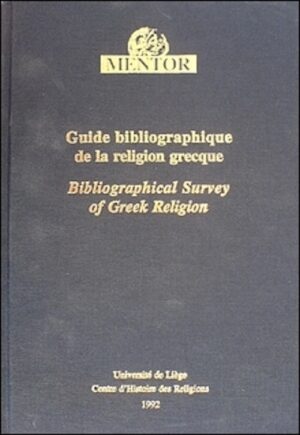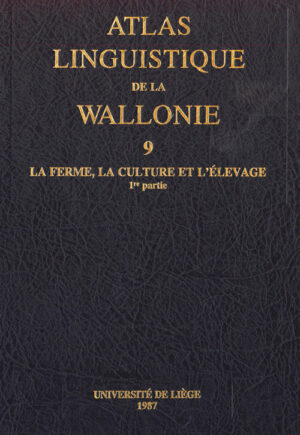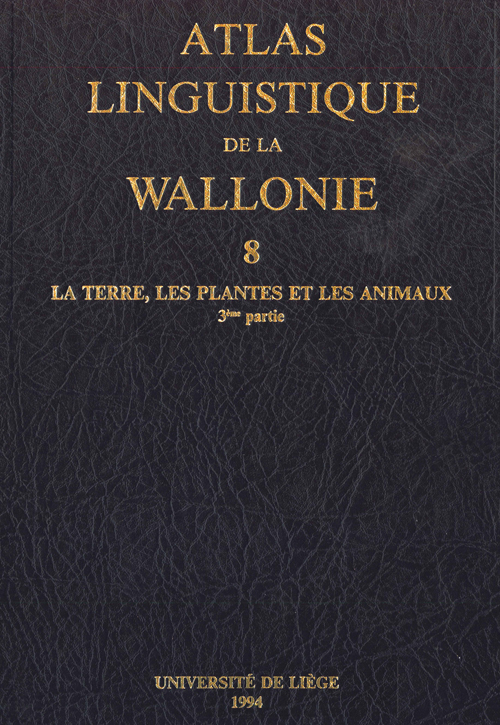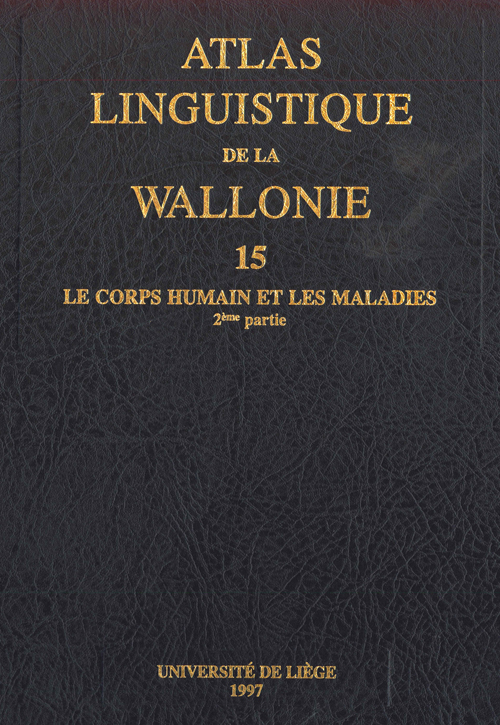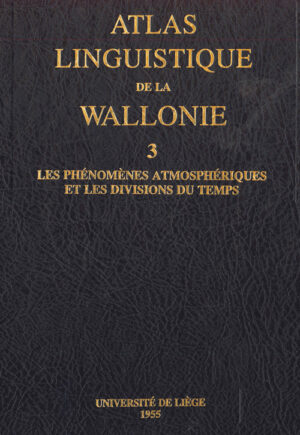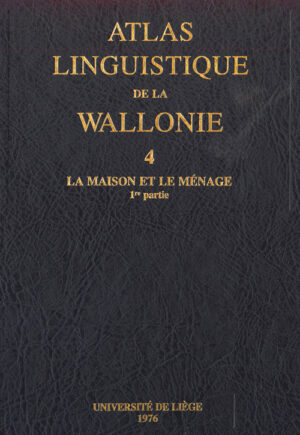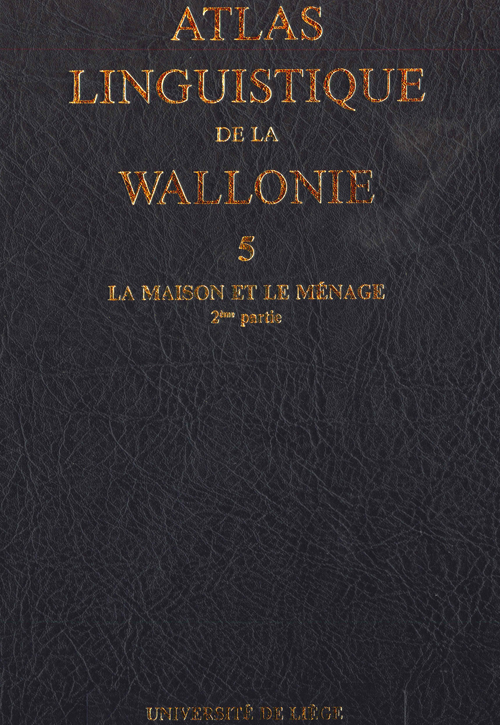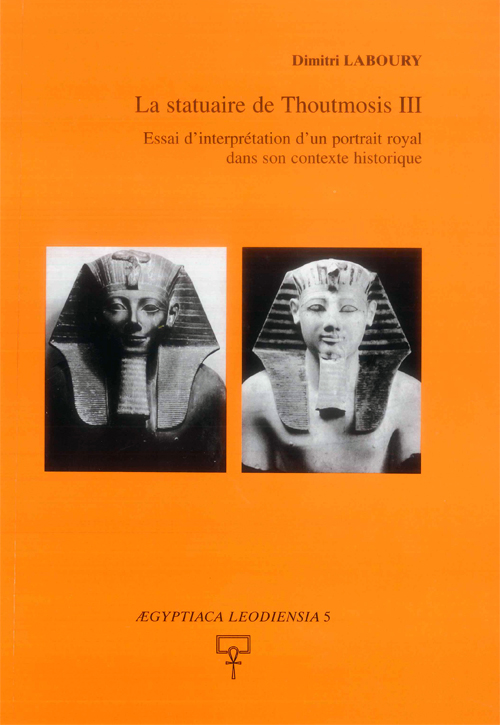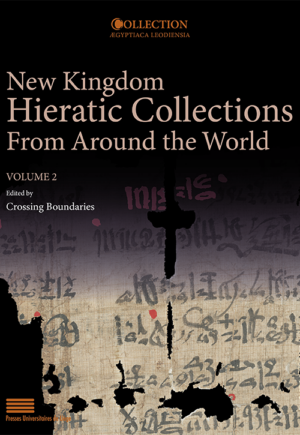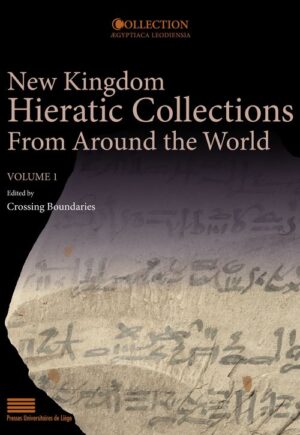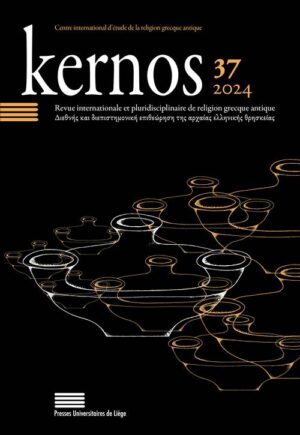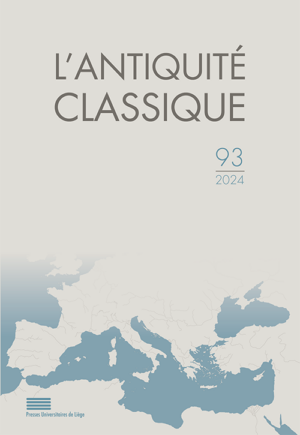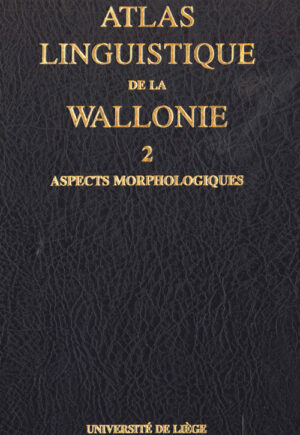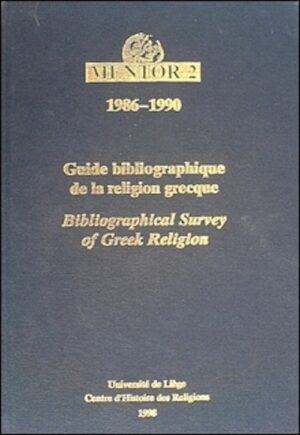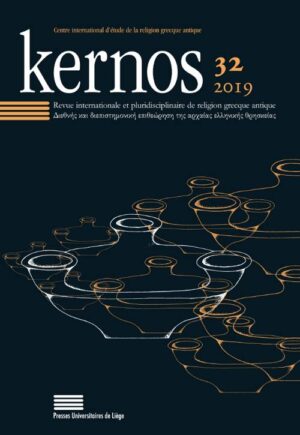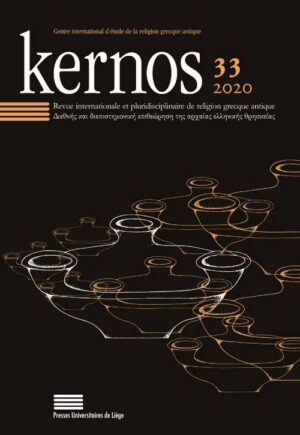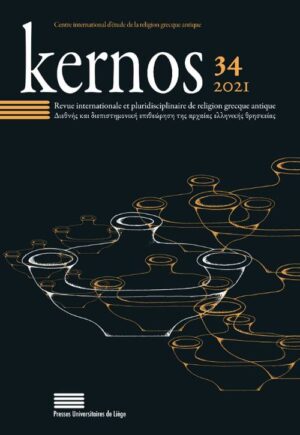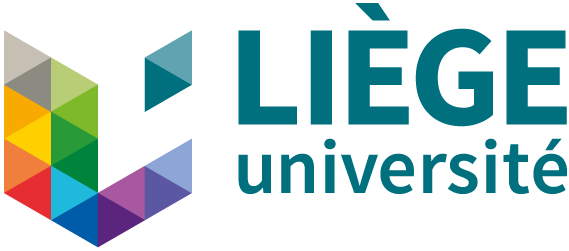-
par M.-G. BOUTIER, M.-Th. COUNET, J. LECHANTEUR La terre les plantes et les animaux (1re partie), 187 notices et 92 cartes. L'ouvrage a été couronné du Prix de philologie de la Communauté française de Belgique. Le tome 6 de l'Atlas linguistique de la Wallonie est le premier d'un ensemble de trois volumes (6 à 8, ce dernier paru) portant le titre général: La terre, les plantes et les animaux. Son objet, qu'explicitent les subdivisions de la table des matières, est le suivant: I. La terre et l'eau, la végétation (la terre, sa nature, son relief: notices 1-10; eaux courantes et dormantes: 11-26; la végétation: 27-40); II. Les routes et les chemins (41-53); III. Généralités sur les plantes (l'arbre, ses parties, son aspect, son développement: 54-74; les fleurs, les fruits: 75-100); IV. Espèces d'arbres et d'arbustes; plantes à fruits (espèces cultivées pour leurs fruits: 101-119; espèces à fruits nommés: 120-157; autres arbres et arbrisseaux: 158-173); V. Activités forestières et arboriculture (174-187). Dans ces volumes comme dans les précédents, les rédacteurs se sont attachés à éditer avec le plus de fidélité possible les très riches matériaux rassemblés par Haust et ses continuateurs et à situer tous les mots dans le cadre géohistorique galloroman. Les volumes sont pourvus d'un index des formes, complété d'un index des étymons (procédure initiée dans le volume 8). Dans chacun, une brève introduction présente l'intérêt des volumes pour la dialectologie wallonne et l'histoire du patrimoine de la Wallonie, ainsi que pour la lexicologie historique.
-
par E. BAIWIR Famille, vie et relations sociales, 160 notices et 66 cartes. L'ouvrage a reçu les Prix de Philologie du Conseil des langues régionales endogènes 2009 de la Communauté Wallonie-Bruxelles; Prix Élisée Legros; Prix Joseph Houziaux de l'Académie royale de Belgique. Le tome 17 de l'Atlas linguistique de la Wallonie est le premier d'un diptyque examinant la vie en société. Il s'organise comme suit: - la famille (1-55); - l'organisation géographique de l'habitat (56-66); - le travail et l’économie (67-81); - les relations amicales (82-93); - les autres interactions humaines (94-160). Dans ces volumes comme dans les précédents, les rédacteurs se sont attachés à éditer avec le plus de fidélité possible les très riches matériaux rassemblés par Haust et ses continuateurs et à situer tous les mots dans le cadre géohistorique galloroman. Les volumes sont pourvus d'un index des formes, complété d'un index des étymons (procédure initiée dans le volume 8). Dans chacun, une brève introduction présente l'intérêt des volumes pour la dialectologie wallonne et l'histoire du patrimoine de la Wallonie, ainsi que pour la lexicologie historique.
-
Simon CONNOR & Vera Elizabeth ALLEN (ed.) This volume originates from a two-part conference held in 2020 and 2021, jointly organised by eikones – Centre for the Study of the History and Theory of the Image at the University of Basel and the University of Liège. It explores the diachronic reception of pharaonic imagery and the conditions that led to its alteration. Paradoxically, iconoclasm—intended to diminish the power of images—ultimately reinforces the significance of the ever-powerful visual, as it continues to provoke strong emotional responses, whether of veneration or destruction. The study of defaced images reveals discernible patterns, yet no universal rule: acts of iconoclasm are deeply influenced by historical, social, and political contexts. In today’s media-saturated world, their impact is further magnified, as exemplified by the destruction of the Buddhas of Bamiyan or the removal of controversial statues during movements linked to Black Lives Matter and post-colonial. By examining traces of mutilation, this double volume seeks to uncover the intentions and motivations behind these acts. Iconoclasm, however, extends beyond mere destruction—images were often repurposed, modified or even buried to imbue them with new meaning. In many cases, defacement specifically targets relevant or even symbolic features, such as body parts associated with identity, ritual significance, or functions in offerings and fertility rites. The contributors draw upon textual sources, material analysis, and archaeological evidence to interpret these transformations. Ultimately, the perception of altered images remains a subject of debate, often shaped by political and ideological narratives. By adopting an interdisciplinary and diachronic perspective, this volume offers a nuanced exploration of the enduring complexity of image destruction and reinterpretation.
-
Guide bibliographique de la religion grecque. Bibliographical Survey of Greek Religion Direction scientifique : A. MOTTE, V. PIRENNE-DELFORGE, P. WATHELET. Traitement informatique : G. PURNELLE, J. DENOOZ Collaboration internationale : plus de 100 spécialistes issus d’une cinquantaine d’institutions. Trois parties principales : Corpus : sélection de 2060 publications classées par ordre alphabétique des auteurs et pourvues d’un numéro d’ordre. Un siècle de bibliographie couvert. Notices analytiques et critiques signées. Deux instruments de consultation : Organon : ensemble de rubriques et de sous-rubriques thématiques offrant un panorama général et hiérarchisé des matières étudiées. Renvois au Corpus. Renvois internes. Renvois à des mots-clés du Thesaurus. Thesaurus : index alphabétique des noms propres, du vocabulaire religieux, des realia et des notions particulières. Renvois au Corpus. Renvois internes. Renvois à l’Organon. Trilingue : français, anglais, grec ancien. Modalités d’accès à la Banque de données (10.000 références). Voir la présentation du programme Mentor.
-
par É. LEGROS, édité et achevé par M.-Th. COUNET La ferme, la culture et l'élevage (1re partie), 164 notices et 51 cartes. Prix «Albert Dauzat» de la Société de linguistique romane.
-
par M.-G. BOUTIER La terre, les plantes et les animaux (3e partie), 194 notices et 100 cartes Prix «Élisée Legros», prix des «Amis de l'Université de Liège», prix de Philologie de la Communauté française de Belgique, prix «Albert Dauzat» de la Société de linguistique romane.
-
par M.-G. BOUTIER Le corps humain et les maladies (2e partie), 165 notices et 65 cartes Prix «Sciences humaines et Folklore Albert Doppagne» de la Fondation Charles Plisnier.
-
par É. LEGROS Les phénomènes atmosphériques et les divisions du temps, 208 notices et 70 cartes
-
par J. LECHANTEUR La maison et le ménage (1re partie), 190 notices et 82 cartes Prix «Élisée Legros».
-
par J. LECHANTEUR La maison et le ménage (2e partie), 180 notices et 64 cartes.
-
Essai d'interprétation d'un portrait royal dans son contexte historique par Dimitri LABOURY 1. Jean WINAND, Le voyage d'Ounamon. Index verborum, concordance, relevés grammaticaux, 1987. 2. Jean WINAND, Études de néo-égyptien, 1. La morphologie verbale, 1992. 3. Pierre KOEMOTH, Osiris et les arbres. Contribution à l'étude des arbres sacrés de l'Égypte ancienne, 1994. 4. Juan Carlos MORENA GARCIA, Études sur l'administration, le pouvoir et l'idéologie en Égypte, de l'Ancien au Moyen Empire, 1997. 5. Dimitri LABOURY, La statuaire de Thoutmosis III. Essai d'interprétation d'un portrait royal dans son contexte historique, 1998. 6. Michel MALAISE & Jean WINAND, Grammaire raisonnée de l'égyptien classique, 1999.
-
Volume II Crossing Boundaries This book is the second in a series of volumes designed to provide a detailed overview of the New Kingdom hieratic materials preserved in various museums and public collections around the world. Each volume is arranged geographically and proceeds in alphabetic order—continent by continent and country by country. Volume 2 contains overviews (and case studies) of 13 European museums and collections, including the French National Library (BnF, Paris), the Louvre (Paris), the Museo Egizio (Turin), the Rijksmuseum van Oudheden (Leiden), and the Vatican Museums. The endeavour is directly connected to the interdisciplinary project Crossing Boundaries: Understanding Complex Scribal Practices in Ancient Egypt, a joint venture of the University of Basel, the University of Liège, and the Museo Egizio (Turin). Since 2019, the Crossing Boundaries project has targeted the rich papyrological materials from the village of Deir el-Medina (c. 1350–1050 BCE) held in the Museo Egizio, seeking to enhance our understanding of the scribal practices that lie behind the production of the texts from this community. The driving methodological motto of Crossing Boundaries has been to adopt a contextualized approach to these written documents. As progress was made on the Deir el-Medina materials, the need to develop a clearer picture of all the hieratic texts available from the same period quickly became evident, which is met by the present publication. Table des matières
- Andrea FANCIULLI, Kathrin GABLER, Jessica IZAK, Martina LANDRINO, Matthias MÜLLER, Renaud PIETRI, Stéphane POLIS, Nathalie SOJIC, Stephan M. UNTER New Kingdom Hieratic Collections From Around the World. Introduction https://doi.org/10.25518/978-2-87562-432-1.01
- Bettina BADER, Charlotte DIETRICH, Johannes JÜNGLING & Julian POSCH New Kingdom Hieratic at the Kunsthistorisches Museum, Vienna https://doi.org/10.25518/978-2-87562-432-1.02
- Vanessa DESCLAUX & Chloé RAGAZZOLI New Kingdom Hieratic Texts in the French National Library With a Focus on an Unpublished Deir el-Medina Archive (P. BN Ms. Égyptien 237) https://doi.org/10.25518/978-2-87562-432-1.03
- Marc ÉTIENNE Le veau du dessinateur Hormin (P. Louvre E 32309) https://doi.org/10.25518/978-2-87562-432-1.04
- Sylvie DONNAT New Kingdom Hieratic Texts in the Strasbourg Collections. An Overview https://doi.org/10.25518/978-2-87562-432-1.05
- Dominique LEFÈVRE Le papyrus Strasbourg 23i+44iii https://doi.org/10.25518/978-2-87562-432-1.06
- Mélanie FLOSSMANN-SCHÜTZE & Maren GOECKE-BAUER Von lehrreichen Texten, Rosinen für die Liebe und einem Wein auf Reisen Hieratika des Neuen Reiches im Staatlichen Museum Ägyptischer Kunst München https://doi.org/10.25518/978-2-87562-432-1.07
- Kata JASPER & Julianna K. PAKSI New Kingdom Hieratic Sources in the Collection of the Museum of Fine Arts, Budapest https://doi.org/10.25518/978-2-87562-432-1.08
- Sara DEMICHELIS, Andrea FANCIULLI & Susanne TÖPFER New Kingdom Hieratic Material in the Museo Egizio in Turin https://doi.org/10.25518/978-2-87562-432-1.09
- Alessia AMENTA, Florence ALBERT, Sara DEMICHELIS & Chiara FORNACIARI DA PASSANO New Kingdom Hieratic Papyri in the Collection of the Vatican Museums https://doi.org/10.25518/978-2-87562-432-1.10
- Daniel SOLIMAN New Kingdom Hieratic Texts in the Collection of the Rijksmuseum van Oudheden in Leiden https://doi.org/10.25518/978-2-87562-432-1.11
- Isabel OLBÉS RUIZ DA ALDA, Esther PONS MELLADO, With Rob J. DEMARÉE, Stéphane POLIS & Federico POOLE Three Objects with Hieratic Inscriptions in the Museo Arqueológico Nacional (Madrid). Wooden Coffin with Stick Shabti 2524 and Ostracon 16243 https://doi.org/10.25518/978-2-87562-432-1.12
- Martin BÜRGE, Rob J. DEMARÉE, Matthias MÜLLER & Malte RÖMER New Kingdom Hieratic Sources in the Archaeological Collection of the University of Zurich https://doi.org/10.25518/978-2-87562-432-1.13
- Dominique LEFÈVRE & Xavier DROUX Les documents hiératiques du Nouvel Empire conservés à la Fondation Gandur pour l’Art, Genève. Un groupe exceptionnel de jarres inscrites en calcite-albâtre https://doi.org/10.25518/978-2-87562-432-1.14
- Ashley COOKE, Roland ENMARCH & Joel SAMS New Kingdom Hieratic Material in World Museum, Liverpool https://doi.org/10.25518/978-2-87562-432-1.15
-
Volume I Crossing Boundaries This book is the first in a series of volumes designed to provide a detailed overview of the New Kingdom hieratic materials preserved in various museums and public collections around the world. Each volume is arranged geographically and proceeds in alphabetic order—continent by continent and country by country. Volume 1 opens with a complete overview of the New Kingdom hieratic material in the Egyptian Museum in Cairo, which is followed by overviews of 18 European museums and 3 North American collections. The endeavour is directly connected to the interdisciplinary project Crossing Boundaries: Understanding Complex Scribal Practices in Ancient Egypt, a joint venture of the University of Basel, the University of Liège, and the Museo Egizio (Turin). Since 2019, the Crossing Boundaries project has targeted the rich papyrological materials from the village of Deir el-Medina (c. 1350–1050 BCE) held in the Museo Egizio, seeking to enhance our understanding of the scribal practices that lie behind the production of the texts from this community. The driving methodological motto of Crossing Boundaries has been to adopt a contextualized approach to these written documents. As progress was made on the Deir el-Medina materials, the need to develop a clearer picture of all the hieratic texts available from the same period quickly became evident, which is met by the present publication. Table des matières
- Andrea FANCIULLI, Kathrin GABLER, Jessica IZAK, Martina LANDRINO, Antonio LOPRIENO, Matthias MÜLLER, Renaud PIETRI, Stéphane POLIS, Nathalie SOJIC, Susanne TÖPFER, Stephan M. UNTER New Kingdom Hieratic Collections From Around the World. Introduction https://doi.org/10.25518/978-2-87562-416-1.01
- Khaled HASSAN New Kingdom Hieratic Texts in the Egyptian Museum in Cairo. Survey and History of the Collection https://doi.org/10.25518/978-2-87562-416-1.02
- Friedhelm HOFFMANN Klagenfurt, Landesmuseum für Kärnten. Zwei neuzeitliche Papyruspäckchen https://doi.org/10.25518/978-2-87562-416-1.03
- Stéphanie BOULET, Luc DELVAUX, Robert J. DEMARÉE, Christian DUPUIS & Benoît LURSON Hieratic Ostraca and Jar Dockets in the Royal Museums of Art and History (Brussels). An Interdisciplinary Edition and Study https://doi.org/10.25518/978-2-87562-416-1.04
- Sofie SCHIØDT New Kingdom Hieratic Texts in Danish Collections https://doi.org/10.25518/978-2-87562-416-1.05
- Jan MOJE The New Kingdom Hieratic Material in the Ägyptisches Museum & Papyrussammlung in Berlin. A Brief Overview https://doi.org/10.25518/978-2-87562-416-1.06
- Hans-Werner FISCHER-ELFERT Ägyptisches Museum der Universität Leipzig https://doi.org/10.25518/978-2-87562-416-1.07
- Maren GOECKE-BAUER, Friedhelm HOFFMANN, Philipp SEYR, Martina ULLMANN, Stefan WIMMER Die hieratischen Papyrusfragmente der Universitätsbibliothek München. P. UBM Cim. 93 (1–3 [= 8o Cod. ms. 431a, 431b, 431c]) https://doi.org/10.25518/978-2-87562-416-1.08
- Martina LANDRINO A Wine-Jar Label in the National Museum of Ireland, Dublin https://doi.org/10.25518/978-2-87562-416-1.09
- Daniela PICCHI, Paul WHELAN & Alessandro GALLI From Egypt to Bologna: Stories of Collectors and Objects Inscribed with Hieratic Texts https://doi.org/10.25518/978-2-87562-416-1.10
- Anna CONSONNI & Federico CONTARDI The New Kingdom Hieratic Collection of the Museo Archeologico Nazionale di Firenze — “Museo Egizio” https://doi.org/10.25518/978-2-87562-416-1.11
- Andrei N. NIKOLAEV & Andrey O. BOLSHAKOV The State Hermitage Museum https://doi.org/10.25518/978-2-87562-416-1.12
- Robert J. DEMARÉE & Andreas DORN Textile and Fish Accounts from the Palace Administration of Ramesses II in Gurob. Fragments of Ramesside Administrative Documents in the Museum Kulturen in Lund https://doi.org/10.25518/978-2-87562-416-1.13
- Andreas DORN Hieratic Texts on Figurative Ostraca: Above, Besides, and Below the Images. Hieratic Documents in the Medelhavsmuseet (Stockholm) https://doi.org/10.25518/978-2-87562-416-1.14
- Andreas DORN Nil novi sub sole? Hieratic Documents in the Museum Gustavianum (the Uppsala University Collection) https://doi.org/10.25518/978-2-87562-416-1.15
- Jean-Luc CHAPPAZ Documents conservés dans les institutions de Genève https://doi.org/10.25518/978-2-87562-416-1.16
- Daniel M. POTTER National Museums Scotland. New Kingdom Hieratic Texts in Edinburgh https://doi.org/10.25518/978-2-87562-416-1.17
- Angela McDONALD & Andrew MILLS New Kingdom Hieratic Texts in The Hunterian, University of Glasgow https://doi.org/10.25518/978-2-87562-416-1.18
- Ilona REGULSKI & Susanne BECK New Kingdom Hieratic Material at the British Museum. Unedited Fragments from a Fake Papyrus Roll in the British Museum (P. BM EA 10720.6 and P. BM EA 10720.4) https://doi.org/10.25518/978-2-87562-416-1.19
- Stephen QUIRKE & Fredrik HAGEN New Kingdom Hieratic in the UCL Petrie Museum of Egyptian and Sudanese Archaeology. Collection-level Summary, and a Preliminary Report on the Gurob Papyri https://doi.org/10.25518/978-2-87562-416-1.20
- Lawrence M. BERMAN & Margaret GEOGA New Kingdom Hieratic Documents in the Museum of Fine Arts, Boston https://doi.org/10.25518/978-2-87562-416-1.21
- Brian P. MUHS & Foy D. SCALF New Kingdom Hieratic Manuscripts in the Oriental Institute Museum (Chicago) https://doi.org/10.25518/978-2-87562-416-1.22
- Foy SCALF, Judith BARR & Sara E. COLE Two New Kingdom Hieratic Manuscripts from the Collection of the J. Paul Getty Museum, Los Angeles https://doi.org/10.25518/978-2-87562-416-1.23
-
Éditorial
Actes du XVIe colloque international du CIERGA (partim) Des dieux, des jeux – et du hasard ?
Vinciane PIRENNE-DELFORGE, Tychè en famille : généalogies et profil divin (Résumé/Abstract) Paulin MAILLARD, Aux origines des attributs de Tychè (Résumé/Abstract) Marco VESPA, Un tripot dans le sanctuaire ? Les skirapheia et le culte d’Athéna Skiras : une construction savante d’époque impériale (Résumé/Abstract) Véronique DASEN, Athéna en jeu. Actualité des débats antiquaires du XIXe siècle sur une partie de Pente Grammai dans la céramique grecque (Résumé/Abstract)Dossier : La notion de « polis-religion » à l’épreuve des normes et de l’autorité religieuse
Vinciane PIRENNE-DELFORGE, Antoine CHABOD, En guise d’ouverture Carmine PISANO, The polis-religion in the mirror of exousia: sources of authority in Greek ritual norms (Résumé/Abstract) Paulin ISMARD, Des cultes en partage : les acteurs de la polis-religion (Résumé/Abstract) Antoine CHABOD, Ni magistrat, ni prêtre ? Les énonciateurs des lois entre normativité civique et pratiques rituelles en Grèce archaïque et classique (Résumé/Abstract) Emily KEARNS, ‘Learning my instructions, Orestes…’: who authorises worship in the Greek world? (Résumé/Abstract) Robert PARKER, Dionysus and polis religion (Résumé/Abstract) Nicole BELAYCHE, Autorités sacerdotales et expériences religieuses individuelles en Anatolie d’après des objets-stèles inscrits (Résumé/Abstract) Paul COURNARIE, La religion de l’appartenance. Normes rituelles, autorité et société dans les cérémonies d’accueil de l’époque hellénistique (Résumé/Abstract) Francesco MASSA, La polis-religion dans l’Antiquité tardive : une notion pertinente pour l’empire romain du IVe siècle de notre ère ? (Résumé/Abstract)Varia
Roy VAN WIJK, Take me to the River: Sanctuaries, Connectivity, and Genealogy in Southern Boiotia and Euboia (800–300 BCE) (Résumé/Abstract) Evan VANCE, Apollo Patroios on Aegina (Résumé/Abstract) Kyle MAHONEY, The Arcadian Nymph Anthrakia and the Lignite Deposits of the Megalopolis Basin (Résumé/Abstract) Chris ATKINS, In a Dark and Glistening Land: Ritual Hexameters, Curse Tablets, and Sacred Rites in Classical Sicily (Résumé/Abstract)Chronique des activités scientifiques
Epigraphic Bulletin 2021 Chroniques bibliographiques -
Articles – Artikels Arnaud Amilien, Quand les motifs mythiques soulignent l’évolution d’un personnage. Le cas de Cyrus chez Hérodote Miriam A. Valdés Guía, El juicio por el Ática: Cecrópidas, Thriai y el voto femenino en Atenas arcaica Christian San José Campos, Ptolemy I and the West. Exemplifying an Unfinished Policy and the Creation of the Western Clause in Alexander’s Hypomnemata Paola Dardano, Strategie di traduzione nei testi biblici. I genitivi assoluti greci nelle traduzioni latine dei Vangeli Georgios Vassiliades, “Don’t Call Me a Monarch!” Truth and Authority in Tiberius’ recusatio imperii (Tacitus, Annales I, 7–13) Simon Lambert, Entre Μάρκος (Ἀντωνῖνος) ὁ φιλόσοφος et Divus Marcus. Étude de l’évolution de l’image posthume de Marc Aurèle et de la (re)construction du souvenir d’un philosophe Jean-Yves Strasser, L. Egnatius Victor Lollianus, de Sardes à Athènes et Nicomédie Mélanges – Miscellanea – Short Notes Marco Gemin, Animali selvaggi e fantastici nel Politico di Platone Fulvio Beschi, Nota a Ov., Am. I, 6, 23 Comptes rendus – Recensies – Book Reviews
-
par Louis REMACLE Aspects morphologiques, 122 cartes et notices.
-
Guide bibliographique de la religion grecque antique. Bibliographical Survey of Greek Religion Il s’agit de la suite du Supplément 1 (1992). Le prix combiné des deux volumes est de 175 Euros. Voir la présentation du programme Mentor.
-
Philippe BORGEAUD, Hommage à Marcel Detienne
Éditorial
par André MOTTE et Vinciane PIRENNE-DELFORGEÉtudes
Bartek BEDNAREK, Orpheus in Aeschylus and the Thracian child-eater on a hydria from the British Museum (Résumé/Abstract) Claudio BIAGETTI, Una menzione di Atena Archegetis in P.Hib. I 15. Note sull’epiteto e sul suo impiego ad Atene (Résumé/Abstract) Sonia DARTHOU, L’olivier, identité et rempart d’Athènes : un épisème de la cité ? (Résumé/Abstract) Julie BALÉRIAUX, Mythical and ritual landscapes of Poseidon Hippios in Arcadia (Résumé/Abstract) Hedvig VON EHRENHEIM, Causal explanation of disease in the iamata of Epidauros (Résumé/Abstract) Dennis D. HUGHES, The Cult of Aratus at Sicyon (Plutarch, Aratus, 53) (Résumé/Abstract) Stefano CANEVA, Variations dans le paysage sacré de Pergame : l’Asklépieion et le temple de la terrasse du théâtre (Résumé/Abstract) Alaya PALAMIDIS, Des souris et des hommes. Une réinvention érudite du culte d’Apollon Smintheus à l’époque hellénistique ? (Résumé/Abstract) Denis ROUSSET, Géographie, paléographie et philologie. Note sur un lieu de culte de Déméter (Résumé/Abstract) Anna ANGELINI, Naming the gods of the others in the Septuagint: lexical analysis and historical-religious implications (Résumé/Abstract) Corinne BONNET, Sylvain LEBRETON, Mettre les polythéismes en formules ? À propos de la Base de Données Mapping Ancient Polytheisms (Résumé/Abstract)Chronique des activités scientifiques
Epigraphic Bulletin 2016, par Angelos Chaniotis Chroniques bibliographiques -
Éditorial
par André MOTTE et Vinciane PIRENNE-DELFORGEÉtudes
Carman ROMANO, Works, Days, and Divine Influence in Hesiod’s Story World (Résumé/Abstract) Edoarda BARRA, Deux nouvelles interprétations du fr. 31 pour une Sappho « anthropologiquement correcte » (Résumé/Abstract) Sylvie VANSEVEREN, Carine VAN LIEFFERINGE, Αἰανής : parjure, démesure et justice divine (Résumé/Abstract) Naomi CARLESS UNWIN, Basket-Bearers and Gold-Wearers: Epigraphic Insights into the Material Dimensions of Processional Roles in the Greek East (Résumé/Abstract) Madeleine JOST, Alaya PALAMIDIS, Points de vue sur Lykosoura. Retour sur le sanctuaire de Despoina (Résumé/Abstract) Jacques DES COURTILS, The “Cupules” of the Herakleion of Thasos (Résumé/Abstract) Jérémy CLÉMENT, La tonte funèbre des équidés et le chagrin d’Alexandre. Origines et interprétations d’une pratique de deuil (Résumé/Abstract) Michael ZELLMAN-ROHER, More on the Tradition of Amulet Pattern-Books in Post-Ancient Copies? (Résumé/Abstract)Chronique des activités scientifiques
Epigraphic Bulletin 2017, par Angelos Chaniotis Chronique archéologique Chroniques bibliographiques -
Éditorial
par André MOTTE et Vinciane PIRENNE-DELFORGEÉtudes
Nicolette PAVLIDES, Heroes, Politics, and the Problem of Ethnicity in Archaic Sparta (Résumé/Abstract) Maria MILI, Croesus’s Lost Shield and other Marvellous Objects (Résumé/Abstract) J.Z. VAN ROOKHUIJZEN, The Erechtheion on the Acropolis of Athens (Résumé/Abstract) Petra PAKKANNEN, Beyond Skin-deep: Considering the Pig in Ancient Greece through the Particularities of Its Skin (Résumé/Abstract) Yulia USTINOVA, “The Story of a New Name”: Cultic Innovation in Greek Cities of the Black Sea and the Northern Aegean Area (Résumé/Abstract) Athanassia ZOGRAFOU, Gods around the Grave: Hermes and Hecate in Early Attic Curse Tablets (Résumé/Abstract) Christopher A. FARAONE, The Lead Tablet from Tongres: Curse or Amulet? (Résumé/Abstract)Chronique des activités scientifiques
Epigraphic Bulletin 2018, par Angelos Chaniotis Chroniques bibliographiques
